How to Fix 0xD000000D with Windows Store
Several Windows users are reaching us with questions after they constantly receive the 0xD000000D error code when opening Microsoft Store or when performing certain actions inside the application. The issue is exclusive to Windows 10 and seems to affect multiple builds. In most cases, affected users report that the issue started occurring after they installed a pending Windows update.
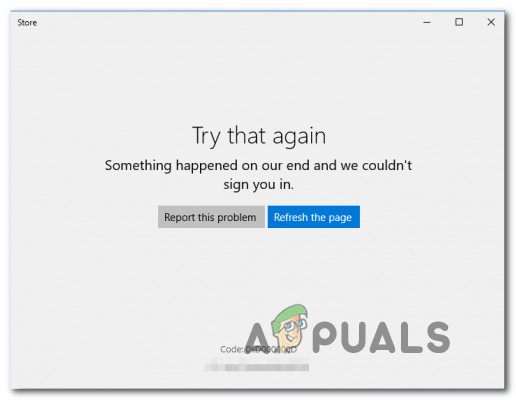
What is causing the 0xd000000D Error in Windows Store?
We investigated this particular issue by looking at various user reports and the repairs strategies that are commonly being used to fix this particular error message. As it turns out, there are multiple potential culprits that can be responsible for this error message:
- Temporary Windows Store glitch – There are several problematic Windows builds (particularly versions 1709 and below) that are known to trigger this error message with Microsoft Store under certain conditions. The issue is already well documented and Microsoft has already developed an automatic fix for it. If this scenario is applicable, you can deploy it easily by running the Windows APp troubleshooter.
- Outdated Windows build – As it turns out, there’s a higher chance of encountering this issue if you’re working with an outdated Windows build. If this scenario is applicable to your current situation and your Windows build is outdated, you will be able to resolve the issue by installing all pending updates for your Windows version.
- User is signed with a local account – The Microsoft Store is notoriously known from acting up in situations where the user tries to download or use certain applications when it’s signed up with a local account. In this case, you will be able to resolve the issue by signing into a Microsoft account instead.
- Corruption inside the Windows Store folder – File corruption is another potential suspect when it comes to this error. This commonly happens after a security suite has quarantined some items used directly or indirectly by the Microsoft Store. If this scenario is applicable, you should be able to fix it by resetting the Windows Store component.
Method 1: Using the Windows App troubleshooting app
Windows Troubleshooter is notoriously known for being unhelpful for the vast majority of fixes, but in this particular case, a lot of affected users have confirmed that they’ve been able to resolve the issue simply by running the Windows Store Apps troubleshooter.
This built-in utility contains a selection of repair strategies that are related to the most common problems faced inside the Windows Store. If you scan your system with this tool and a problem is found, the utility will automatically recommend the most suitable strategy that has the highest chance of resolving the issue.
Here’s a quick guide on running the Windows Store App troubleshooter:
- Press Windows key + R to open up a Run dialog box. Then, type “ms-settings:troubleshoot” and press Enter to open up the Troubleshooting tab of the Settings app.
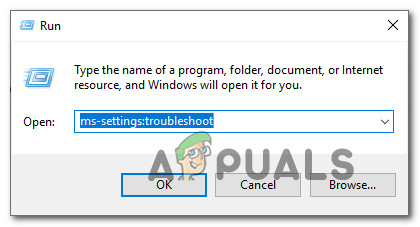
Accessing the Activation troubleshooter - Once you’re inside the troubleshooting tab, scroll down to the Find and fix other problems tab, then click on Windows Store tab to bring up the context menu and click on Run the troubleshooter.
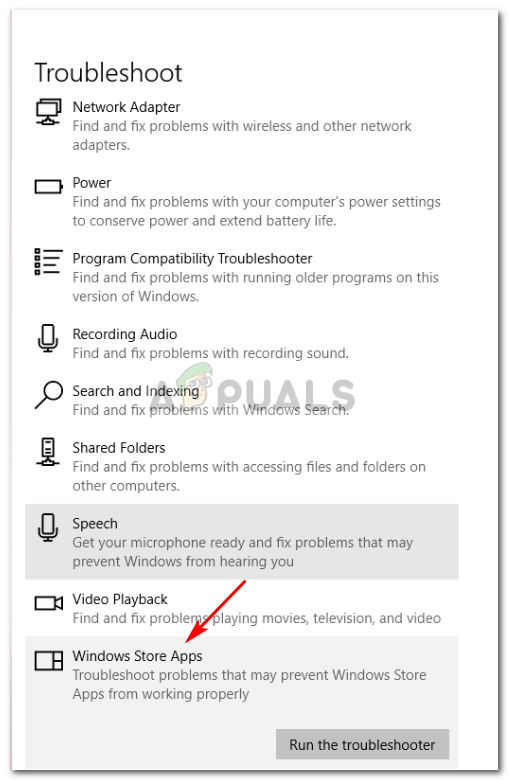
Run Windows Store Apps troubleshooter\ - Inside the Windows Store Apps troubleshooter, initiate the scan and wait for it to complete. If a problem is found, the troubleshooter will automatically recommend the most suitable repair strategy. If this happens, click on Apply this fix – this will automatically apply the recommended repair strategy.

Apply this fix - Once the fix is successfully applied, see if the issue has been resolved at the next system startup by restarting your computer.
If the issue still persists after the next startup sequence is complete, move down to the next method below.
Method 2: Installing every pending Windows update
As it turns out, you might also be able to resolve the issue by ensuring that you install all the pending updates available for your Windows installation. If the issue was introduced by a bad update that Microsoft has since rectified, you will be able to fix the 0xD000000D error code by installing every available update.
Several affected users have reported that they managed to fix the issue on Windows 7 and Windows 10. Here’s a quick guide on how to install every Windows update in order to fix this issue:
- Press Windows key + R to open up a Run dialog box. Then, type ‘ms-settings:windowsupdate’ and press Enter to open the Windows Update tab of the Settings app.

Opening the Windows Update screen Note: If you have Windows 7 or older, use the “wuapp” command instead.
- When you arrive inside the Windows Update screen, click on Check for updates, then follow the on-screen prompts to install every pending update (including cumulative and security updates)
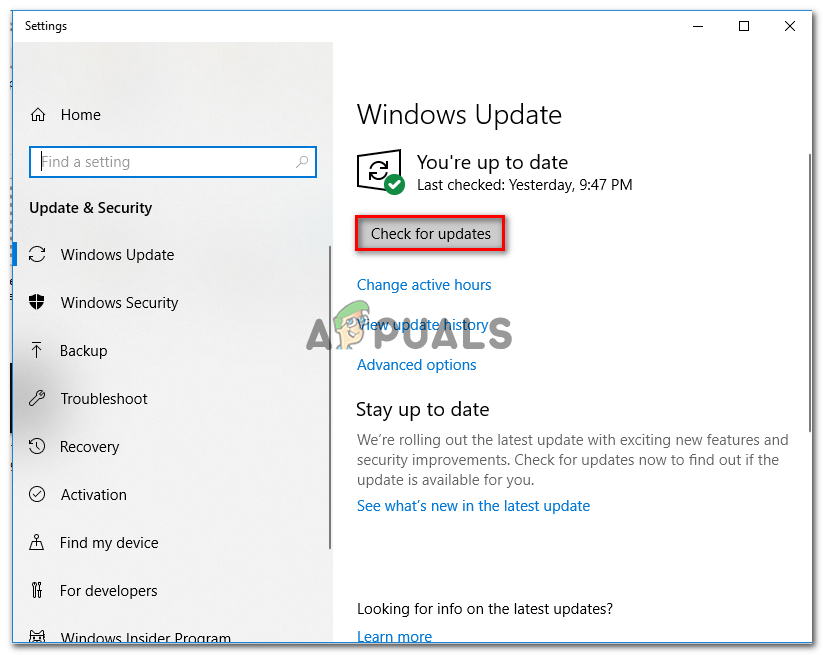
Installing every pending Windows update Note: If you’re prompted to restart before every update is installed, do so but make sure to return to this screen and continue with the installation of the rest of updates until your computer is up to date.
- Once everything is installed, restart your computer and see if the issue is resolved at the next startup.
If you’re still encountering the 0xD000000D error code, move down to the next method below.
Method 3: Sign into a Microsoft Account
As several different users have reported, the 0xD000000D error code might occur in situations where you are signed into a local account instead of using a Microsoft Account. Windows Store is one of the many Windows 10 applications that are known to malfunction in instances where the user is using a local account.
If this scenario is applicable to your current situation, you should be able to resolve the issue very easily by accessing the Account tab and signing in with a Microsoft account instead.
Here’s a quick guide on how to sign in with a Microsoft account:
- Press Windows key + R to open up a Run dialog box. Next, type “ms-settings:emailandaccounts” inside the Run text box and press Enter to open up the Email & app accounts tab of the Settings app.
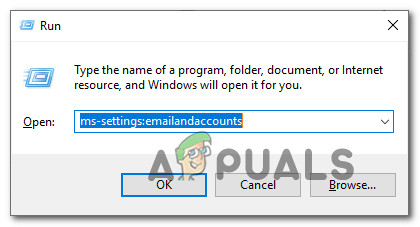
Opening the Email & app accounts of the Settings page - Once you’re inside the Email & accounts tab, scroll down to the Accounts used by other apps section and access the Add a Microsoft account (If you don’t have an account) or Sign in with a Microsoft account instead (if you already have an account)
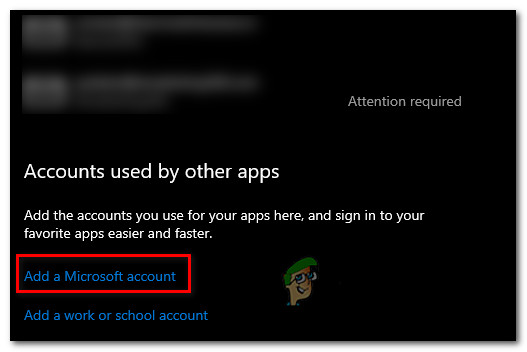
Connecting with a Microsoft account - Once you reach the next screen, insert the require user credential to login with your Microsoft Account. If you don’t have an account, click on Create one! and follow the on-screen instructions to create a new Microsoft account.
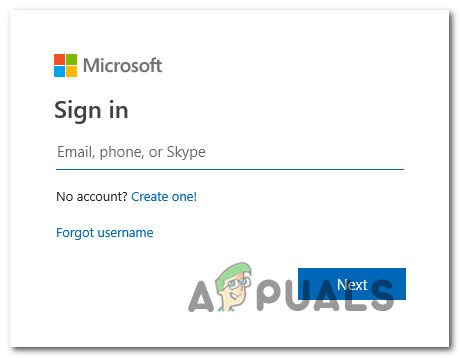
Connecting with a Microsoft account - Once you are connected with a Microsoft account instead of using a local account, restart your computer and wait for the next startup sequence to complete.
- When the procedure is complete, open Microsoft Store again and repeat the action that was triggering the 0xD000000D error code and see if the problem has been resolved.
If the issue is still occurring, move down to the next method below.
Method 4: Resetting Windows Store
If none of the methods above have allowed you to resolve the issue, let’s try a more drastic approach. It’s also possible that the Microsoft Store 0xD000000D error code occurs due to file corruption. Most commonly, this is confirmed to occur in instances where a security suite has previously quarantined some items or after a failed Windows update.
Several users in a similar scenario have reported that the issue was resolved after they reset all Windows Store components. There are two different ways of doing this effectively. We are going to feature both, so feel free to follow whichever method is more approachable to your technical abilities.
Resetting Windows Store via the Settings app
- Press Windows key + R to open up a Run dialog box. Then, type ”ms-settings:appsfeatures’ inside the text box and press Enter to open up the Apps & Features tab of the Settings app.
- When you’re inside the Apps and features screen, scroll down through the list of applications (under Apps & features) and locate Microsoft Store.
- Once you manage to locate it, click on Advanced options (under Microsoft Corporation).
- Next, move over to the Reset tab and click the Reset button. When prompted by the confirmation prompt, click on Reset once again.
- Once the procedure is complete, restart your computer and see if the issue is resolved once the next startup sequence is complete.

Resetting Windows store via elevated Command Prompt
- Press Windows key + R to open up a Run dialog box. Next, type “cmd” inside the text box and press Ctrl + Shift + Enter to open up an elevated Command Prompt. When you’re prompted by the User Account Control (UAC) click Yes to grant administrative privileges.

Running CMD as an administrator - Once you’re inside the elevated Command Prompt, type “‘WSRESET.EXE” and press Enter to reset Windows Store along with all it’s associated dependencies.

Resetting Windows Store - When the process is complete, restart your computer and see if the issue is resolved at the next startup sequence.




